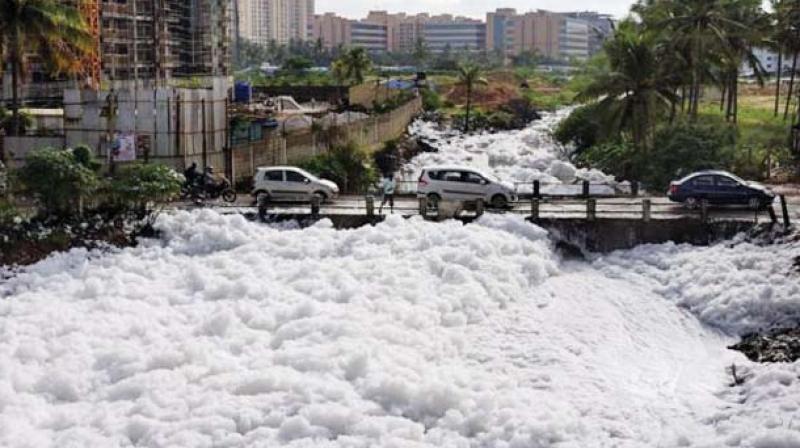By invitation: Why our roads are full of potholes, our lakes filled with sewage

Earlier this week, the National Green Tribunal took a definitive stand to protect Bellandur lake, ordering a total shut-down of all industries in the vicinity of the water body. The bench, headed by NGT Chairperson Justice Swatanter Kumar noted that no industry will be allowed to operate unless effluents are analysed and found to be within permissible limits by a joint inspection team.
Over the years, Bellandur Lake, which has been at the heart of the city's IT boom, has paid the price for Bengaluru's development. Once a thriving agrarian neighbourhood, the crops that do continue to grow there now receive their nourishment from the polluted lake waters. A number of garages and textile units sprung up in the neighbourhood, as did towering apartment complexes constructed by greedy builders who encroached mercilessly upon the lake bed. In light of all this, the NGT's stand is very welcome indeed!
Now the question we need to ask ourselves is — how have we arrived at this point? Bengaluru was home to a network of hundreds of lakes, which gave the city its verdant beauty and its famous weather. As it happens, Bellandur, in its peak, was one of the city's largest lakes. Over the years, numerous agencies have been involved in the running and maintenance of these water bodies. In fact, the popular belief is that Bellandur Lake belongs to the BDA. The government went on to form the Lake Development Authority and gave it the responsibility of monitoring and maintaining our water bodies. The LDA, however, was run by a section of the Forest Department and found itself constantly short of personnel. Instead of seeing to and tightening regulations in the area, industries were allowed to grow, many of them illegal.
Garages and textile factories which didn't know what to do with their effluents found in Bellandur Lake a most convenient waste disposal zone. This is a trait peculiar to Indians - we don't drink the lake water and are not directly affected by its pollution, so we don’t bat an eyelid over turning it into a dumping ground. Apartment complexes mushroomed as well, all with permissions granted by authorities like the BBMP and BDA, which lack any kind of conviction in their approach. The Karnataka State Pollution Control Board, of which I was a member for five years, the BDA and BBMP have a vague, "anything goes" attitude toward land development. They are, quite simply, not committed institutions.
And how can they be? India is not an industrialised country, we're starkly different still, from our western counterparts. Most of these countries took nearly two centuries to get an all-encompassing urban policy in place. Numerous issues presented themselves along the way and the solution was a process comprising various technological interventions. Challenges like water pollution, air pollution and traditional differences were addressed one after another before a feasible system was put in place to achieve social democracy. The concept of democracy, after all, is not limited to politics alone. We need to be socially and culturally sound as well. In the space of those 150 years, they were presented with unemployment, so they created jobs. Younger generations thrived and the elderly were neglected, so world-class hospitals were set up. It's a journey and each one is different.
India, however, is still grappling with the cultural changes that industrialisation has brought with it. Large numbers of people migrate to cities from rural areas, with no connection to the city save for the financial opportunity it presents. Our urban areas are too young to have established a collective identity and what we have instead, is an assortment of people with varying degrees of social commitment to the city in which they live. For instance, Bengaluru has around 80,000 cabs, most of which are driven by people who have migrated to the city from rural areas. These people make a good living but are not 'urbanised' yet. The same goes for government jobs, which were, at one point, widely deemed a stable, most desirable option. Young, highly paid techies buy apartments in areas like Sarjapur and Whitefield without ever stopping to question if builders have encroached a lake bed or a storm water drain. BBMP engineers come from small towns and behave as such - with a lacklustre attitude toward long-term ur
ban development. We hand over our biggest projects to private entities, but a basic civic duty like building a road, for instance, is in the hands of these people. That's why our roads are full of potholes and our lakes filled with sewage.
Let's do what we can for Bellandur Lake, which has been suffering since 1990, when the IT boom first began, reaching unprecedented proportions after 2005. It's hard to say what can be done for our ailing water body - can the authorities remove the water and muck collected over four decades? A lake as large as Bellandur also requires a large catchment area, which encroachments have deemed impossible. The odds are stacked against a total recovery but the NGT has done a good thing by sending a notice to the government. Perhaps it will spur them into action, which certainly wouldn't have been taken otherwise.

